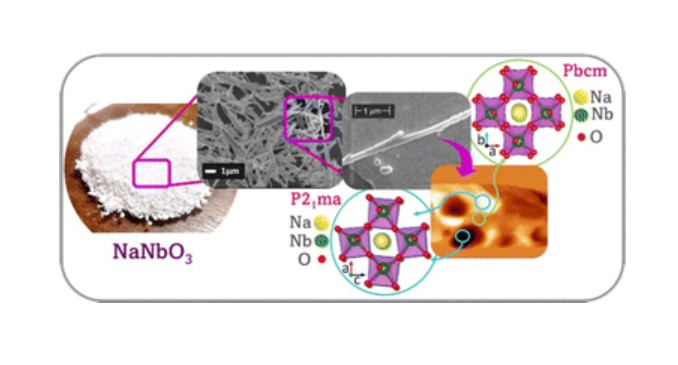


The method was described in an article published in the Journal of Materials Chemistry C (image: Journal of Materials Chemistry C)
Published on 04/03/2024
Agência FAPESP* – Sodium niobate (NaNbO3) is a type of ceramic known for its piezoelectric properties, which allow it to generate electricity through mechanical pressure. It is considered promising in areas such as photocatalysis and green chemistry, which includes the degradation of pollutants in wastewater. The material can also be used in energy harvesting and storage devices.
In collaboration with groups from other institutions, researchers from the Center for Development of Functional Materials (CDMF) in Brazil have obtained sodium niobate fibers from sodium metaniobate (Na2Nb2O6·H2O). The method was described in an article published in the Journal of Materials Chemistry C.
The CDMF is a FAPESP Research, Innovation and Dissemination Center (RIDC) based at the Federal University of São Carlos (UFSCar).
During the synthesis of the material, dodecahedrons of NbO7 and octahedrons of NbO6 are formed, which bind at the vertices to form Nb6O198- ions, responsible for producing different structures and compositions of niobates. The Nb6O198- ions incorporate the Na+ ions present in the reaction medium to form Na2Nb2O6·H2O fibers.
By subjecting these fibers to a conventional heat treatment, water molecules were released in a structural arrangement that resulted in NaNbO3 fibers with an orthorhombic crystal structure and piezoelectric properties. The orthorhombic structure is one of the seven structures in which a crystal can be organized. It is characterized by the presence of three axes of unequal length that form right angles to each other.
After synthesis, the material was analyzed in powder form. It was characterized using different techniques such as X-ray diffraction with Rietveld refinement, Raman spectroscopy, high-resolution scanning electron microscopy and piezoelectric force microscopy.
It was concluded that it is possible to obtain sodium metaniobate particles in the form of fibers by microwave-assisted hydrothermal synthesis in 40 minutes at a temperature of 160 °C in polyvinyl acetate medium. It was also observed that the sodium niobate fibers have a mixture of ferroelectric and antiferroelectric orthorhombic phases. Ferroelectricity is the property of some piezoelectric materials to reverse their electrical polarization when an external electric field is applied.
Research on the material is ongoing. The team is now investigating the relationship between different heat treatment temperatures, structure, properties and different applications, as well as the characteristics of flexible composites formed from NaNbO3 fibers and polymers such as polyvinylidene fluoride, and their potential applications in energy harvesting devices.
According to Miguel Angel San Miguel Barrera, a researcher affiliated with the CDMF and one of the authors of the article, this is an example in which atomistic simulations based on density functional theory have provided relevant information about the electrical properties of a multifunctional material.
The study On the coexistence of ferroelectric and antiferroelectric polymorphs in NaNbO3 fibers at room temperature can be accessed at: pubs.rsc.org/en/content/articlelanding/2023/tc/d2tc04039e.
* With information from CDMF, a FAPESP Research, Innovation and Dissemination Center.
Source: https://agencia.fapesp.br/51293